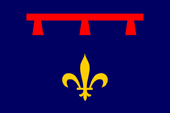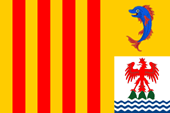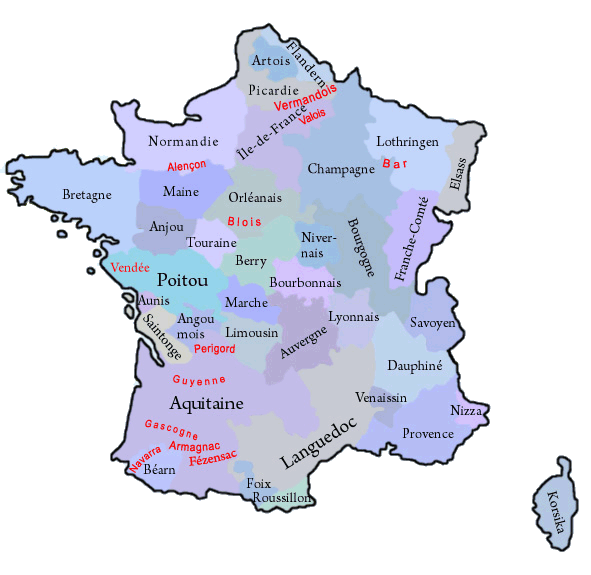mobile View, to the German Version tap the flag


- historical region in today's France
- former county and province
• Flag
• Meaning/Origin of the Flag
• Coat of Arms
• Meaning/Origin of the Coat of Arms
• Map of the historical Regions in France
• Explanations about the Regions
• History
• Origin of the Country's Name

Flag of Provence
– Drapeau de Provence,
Source, by: Die Welt der Flaggen






since 1999,
Flag of Provence-Alpes-Côte d’Azur Region
– drapeau de la région Provence-Alpes-Côte d’Azur,
Source, by: Flags of the World






The flag of Provence is a scutcheon-flag, it shows the image of the coat of arms. It goes back to Charles of Anjou, the brother of King Charles V., after he became the Count of Provence, when he merried Beatrix of Barcelona in 1245. Since 1999 is in the region of "Provence- Alpes-Côte d’Azur", to which the Provence belongs, a flag in use, which combines the features of the heraldry of the County of Barcelona (Provence belonged from 1112 to 1245 to the County of Barcelona), of the County of Dauphiné and of the County of Nice.
Source:
Volker Preuß


1112–1245,
Coat of arms of the County of Barcelona, to which Provence belongs in this time
– Blason de la Comté de Barcelone, Provence entendu à ce moment pour ce pays,
Source, by:
Wikipedia (D)

1246–1382,
Coat of arms of Anjou
– blason de Anjou,
Source, by:
Wikipedia (D)

1382-1481,
Coat of arms of Anjou
– blason de Anjou,
Source, by: Wikipedia (FR)

since 18th century,
Coat of arms of Provence
– Blason du Provence,
Source, by:
Wikipedia (FR)

When the Counts of Arles – which ruled until that point of time over the Provence – extincted in 1112, the Provence came as heir to Count Ramon Berenguer of Barcelona. The land remained in the ownership of the Counts of Barcelona until their extinction in 1245, and during this time the coat of arms of the County of Barcelona was used. The heiress and daughter, Beatrix, had meantimes married Charles of Anjou. He was a brother of King Louis IX. of France, in this way the Provence came to the house of Anjou (Anjou-Provence). This was also visible in the coat of arms. The heraldry of Charles of Anjou showed the lily-scutcheon of the Capetians, supplemented with a red tournament collar with three flaps, which featured Charles – following the rules of the French heraldry – as a younger son. The heiress of the House of Anjou Johanna of Naples adopted Ludwig (son of King John the Good of France) as her successor. The younger line of Anjou in this way took over, but Johann inherits only the Provence. The coat of arms of the Capetians showed three golden lilies on blue, but originally was the coat of arms sprinkled with lilies. From 1365 (by others sources 1376), the number of lilies was reduced to three. The lily-symbol is very old, already the Germanic tribe of the Franks has used it. The House of the Capetians has provided the kings of France between 987 and 1328. It goes back to Hugo Capet, son of Hugo the Great, who was electet to the King of France, in 987, after the death of King Ludwig V. from the House of the Carolingians. The Capetians brought out three branch lines which became the Kings of France: Valois 1328–1589, Bourbon 1589–1792 and 1814–1830, and Orléans 1830–1848.
Source:
Wikipedia (D),
Volker Preuß

The historical, French Regions:

in black: governorate and province in 1776,
in red: former county, province oder governorate
Map: Volker Preuß

The until the French Revolution existing provinces (or governorates) have been historically grown structures, which had their roots oftenly in former fiefdoms of the French crown, historic counties and duchies. They oftenly existed for hundreds of years and had preserved regionality (e.g. cultural particularities and regional languages). On the occasion of the French Revolution such phenomena were of course not desirable, and as part of their bloody and violent egalitarianism any regional references were eliminated. Shortly after the French Revolution the provinces were dissolved and France became divided into many départements, which should have approximately the same size and the same status. The départements were named after rivers or mountains, to use never and in no circumstances the name of an old province. However, there was no success in cutting the connections of the people of France to their respective regions, so that administrative regions were re-created in 1960, to have a better control in regional administrative processes. In this way became départements, which were placed in a historical province, administratively grouped to an oftenly historically named region. The resulted structures coincide only approximately with the boundaries of the old provinces. In the strictly centralist France any regionality is avoided, so that even the official flags of these regions mostly look like flags of companies, unloving, unhistorical, technocratic and modernistic, and these flags should not be a subject of any lexical considerations here. Only in a few of that regions, exist official flags which remember the historical models. But, even the existence of these today's regions is douptful, because in 2014 was passed a territorial reform valid from the year 2016, that reduces the number of the existing regions by merging to nearly the half. However, there exist unofficial flags in nearly all of these regions, which should remember the old provinces and the old heraldry.
Wikipedia Link to the regions of France:
click or tap here
FOTW Link to the regions of France:
click or tap here
Source: Flags of the World,
Wikipedia (D),
Volker Preuß

antiquity · settlement by the Ligurian tribe of the Sallusians
125 B.C. · military victory of the Roman Consul Fulvius against the Sallusians
123 B.C. · the area of the Sallusians is annexed to the Roman Empire, the today's territories of Languedoc, Dauphiné and Savoy get merged as "Provincia"
58–52 B.C. · Roman conquest of Gaul, the area of Sallusians comes to the province of Gallia Narbonensis, but the name "Provincia" remains in common use
4th/5th century A.D. · the Burgundians come from the region between the Oder River and Vistula River and invade into the Roman Empire, settle on the Middle Rhine near Worms and plunder neighboring Roman settlement areas
436 · the Kingdom of Burgundy in the Middle Rhine area is shattered by Huns in Roman service
443 · the surviving Burgundians get settled by the Romans in the area of Lake Geneva and the today's Savoy
ca. 443 · arise of the Kingdom of Burgundy (Burgundia), expansion of the territory south to the River Durance, the territories from there down to the Mediterranean Sea remain as "Provincia" at the Roman Empire
470 · the Visigoths conquer "Provincia"
508 · "Provincia" comes to the Kingdom of the Ostrogoths under Theodoric the Great
534 · conquest of the Kingdom of Burgundy by the Franks
536 · the Ostrogothic King Vitiges cedes "Provincia" to the Frankish King Theodebert
870 · at the division of the Frankish Empire (Treaty of Meersen) arises the West Frankish Kingdom, the East Frankish Kingdom, and the Frankish Kingdom of Italy – Burgundy gets divided, the north (Upper Burgundy) comes to the West Frankish Kingdom, the south (Provincia) comes to the Frankish Kingdom of Italy
877 · Lower Burgundy (including Provincia) separates from Italy
880 · by the division of the Frankish Empire (Treaties of Verdun and Ribbemont) arises the West Frankish Kingdom (later France), the East Frankish Kingdom (later German Empire), the Kingdom of Italy, the Kingdom of Upper Burgundy, the Kingdom of Lower Burgundy (including Provincia ) remains
951 · Upper Burgundy and Lower Burgundy become united to the Kingdom of Burgundy, under Conrad III. of Upper Burgundy, this country is also called Arelat
1033 · the Kingdom of Burgundy (Arelat) comes as an inheritance to the German Empire, the Roman-German Emperor Conrad the Elder is elected in Peterlingen (Payerne) to the king of Burgundy, but in subsequent years, the country is divided into several counties (County of Provence, County of Venaissin, County of Savoy, County of Dauphiné, Franche-Comté), the last king of Burgundy is the Emperor Charles IV., who was enthroned in 1365
1112 · the Counts of Arles, until that point of time ruling over Provincia (French: Provence) extinct, the inheritance goes to Count Ramon Berenguer of Barcelona
1245 · death of Ramon Berenguer IV., Count of Barcelona (the Barcelona County is part of the Kingdom of Aragon), the heiress and daughter Beatrix gets married with Charles of Anjou (brother of Louis IX. - the Holy - King of France), in this way comes the Provence to the House of Anjou (Anjou-Provence)
1382 · Johanna I. of Anjou-Provence appoints Louis I. (Duke of Anjou, son of King John the Good of France, brother of Charles V., King of France) as heir, the Provence comes in this way to the younger line of the House of Anjou
1487 · Charles VIII., Count of Provence and Count of Dauphiné (son of the French King Louis XI.), brings the Provence to the French crown, he inherited the Provence from Charles III. (son of Louis I. of Anjou), that was the leaving of Provence from the Holy Roman Empire of German Nation, which had only existed nominally since 1378 (the death of the last King of Burgundy)
17th–18th century · the Provence (as part of the French crown) is just a province, the country is involved in the civil administration of the Kingdom of France and has a governmental administration, but it is equipped with some special rights of a estates state, what could be an own estates assembly (a kind of parliament) or may even mean an own tax jurisdiction towards the king
1776 · the already in the 14th century created governorates of the civil administration of the kingdom of France become committed to a number of 39, and correspond in this way to the number of provinces, in previous years could any provinces be summarized in one governorate
1789 · French Revolution, the governorates (provinces) become abolished, the Provence is divided into departments (mainly Alpes-de-Haute-Provence, Var, Vaucluse and Bouches-du-Rhône)
1960 · reintroduction of regions in France, forming of the region of Provence-Alpes-Côte d' Azur, with its capital Marseille, but not within the historic boundaries, just by integrating of the departments of Alpes-de-Haute-Provence, Var, Vaucluse, Bouches-du-Rhône, Hautes-Alpes and Alpes-Maritimes
Source:
Wikipedia (D),
Meyers Konversationslexikon

The name "Provence" goes back to the year 123 B.C., when the area of the Sallusians was incorporated into the Roman Empire, and the territories of today's Provence, Languedoc, Dauphiné and Savoy were summarized as "Provincia" (province). The name "Provincia" remained in common use over the centuries.
Source:
Meyers Konversationslexikon


![]()












